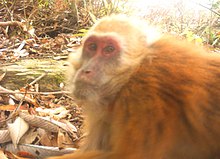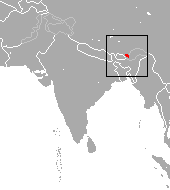Arunachal macaque
| Arunachal macaque | |
|---|---|

| |
| Arunachal macaque from Bugun and Shertukpen forests around Eaglenest WLS | |
| Scientific classification | |
| Domain: | Eukaryota |
| Kingdom: | Animalia |
| Phylum: | Chordata |
| Class: | Mammalia |
| Order: | Primates |
| Suborder: | Haplorhini |
| Infraorder: | Simiiformes |
| Family: | Cercopithecidae |
| Genus: | Macaca |
| Species: | M. munzala
|
| Binomial name | |
| Macaca munzala | |

| |
| Arunachal macaque range | |
The Arunachal macaque (Macaca munzala) is a
It was
It is a relatively large brown primate with a comparatively short tail. Its species name comes from mun zala, meaning deep forest (mun) monkey (monkey), as it is called by the Monpa people of West Kameng and Tawang.[2]
Discovery

It was discovered as a new taxon in 1997 by the Indian primatologist
Subsequently, it was also discovered in Bhutan, where it was observed and photographed in the Trashi Yangshi area in 2006.[4]
Description
The Arunachal macaque is compactly built and has a very dark face. It lives at high altitudes, between 2000 m and 3500 m above sea level, making it one of the highest-dwelling primates. It belongs to the M. sinica species-group of macaques, along with the
The Arunachal macaque is apparently physically similar to the Assam and Tibetan macaques, while genetically closely related to the bonnet macaque of southern India. This is probably the result of convergent evolution, where organisms evolve similar physical features due to similar environmental selection pressure, while genetically they may have different origins.[7]
Kumar et al. (2008) and Sinha et al. (2006) report at least 569 individuals in thirty-five troops; thirty-two troops in Tawang and three troops in West Kameng.[1] The monkey is severely persecuted in some parts of its known distribution by locals retaliating against crop raiding.[2]
Further reading
- Sinha, A.; Chakraborty, D.; Datta, A.; Gama, N.; Kumar, R. S.; Madhusudan, M. D.; Mendiratta, U.; Ramakrishnan, U.; Mishra, C. (2013). "Arunachal macaque Macaca munzala (Sinha, Datta, Madhusudan and Mishra 2005)". In Johnsingh, A. J. T.; Manjrekar, N. (eds.). Mammals of South Asia – Volume 1. Hyderabad, India: Universities Press. pp. 198–210. ISBN 9788173715907.

